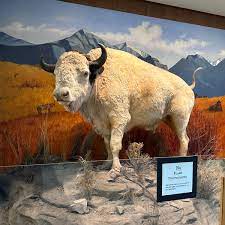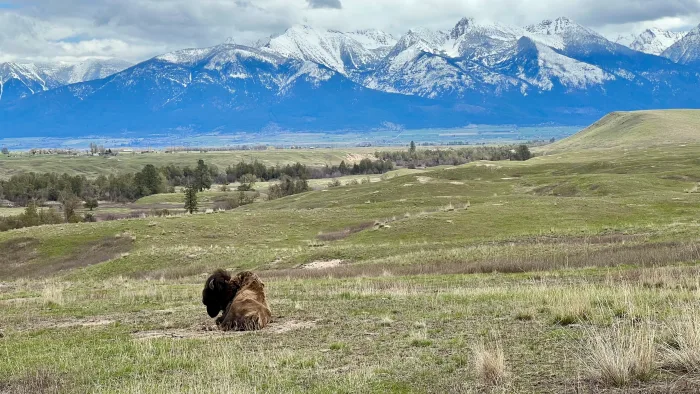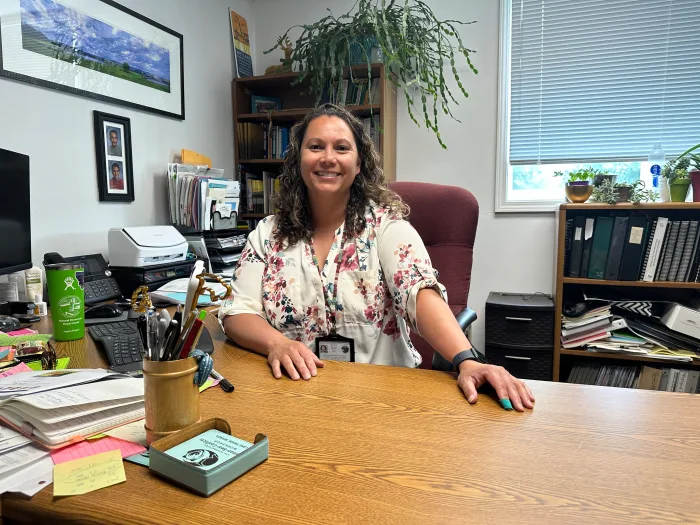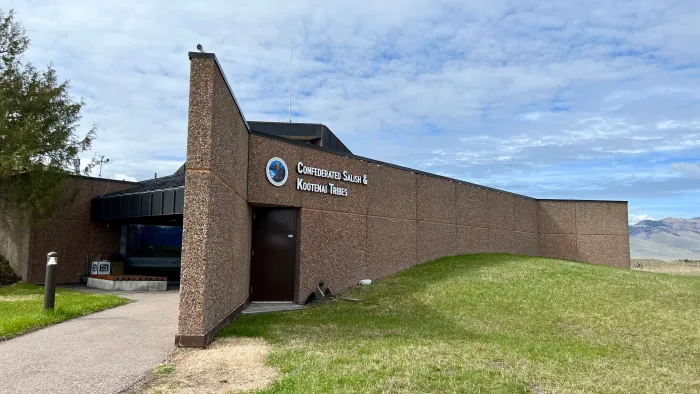News Based on facts, either observed and verified directly by the reporter, or reported and verified from knowledgeable sources.
Regaining the land and the white bison
 Big Medicine, the white bison born on the Confederated Salish and Kootenai Tribes Bison Range, is displayed in the Montana Historical Museum in Helena, Montana, May 23, 2023. (JoVonne Wagner, ICT and MTFP)
Big Medicine, the white bison born on the Confederated Salish and Kootenai Tribes Bison Range, is displayed in the Montana Historical Museum in Helena, Montana, May 23, 2023. (JoVonne Wagner, ICT and MTFP)
Among the plans the Confederated Salish and Kootenai Tribes have in story for its newly regained bison refuge is securing a home for the long lost Big Medicine
Big Medicine was born in 1933 on the range of the Flathead Indian Reservation in western Montana. The rare white bison had become revered in his lifetime on the land called home to the Confederated Salish and Kootenai Tribes.
He lived for about 36 years, then he died in 1959. Because he lived on a national wildlife refuge, as managed by the U.S. Fish and Wildlife Services, the tribes lost control of Big Medicine. Big Medicine was taxidermied, and for more than six decades, has been under management and ownership of the state, on display at the Montana Historical Society.
The tribe has made concerted efforts to regain control of Big Medicine. Along a similar front, the tribe has also worked to regain control of management of the land that make up the Flathead reservation, including the wildlife refuge that the white bison knew as home.
“His [Big Medicine] return to the Flathead Reservation would further our peoples’ healing process and provide a unique opportunity for the Montana Historical Society to right a wrong in our shared history,” tribal leaders stated in a 2022 letter to the state, officially requesting that Big Medicine be returned home.
Now, both the state and federal government agree. As the tribe has taken over management of the wildlife refuge, it also now has a solid plan in place to bring Big Medicine home. Although there is no timeline set, the tribe has a significant to-do list to accomplish before the actual move.
The project is the result of the coordinated efforts of the Montana Historical Society and the state in a project that seeks to repatriate Indigenous artifacts and culturally significant items back to tribes. This includes Big Medicine, who was moved from the reservation in 1961 to the historical society in Helena, the state’s capital.
The first peoples of the Flathead, noticed quickly the rapid decline of buffalo during the era of European expansion and colonization. According to tribal history, Atatice? who was a Qlispé man, had a vision to save the bison from extinction. His son, Łatato, carried out his father’s dream and helped the tribes secure the initial bison herd.
In the late 1800s, two tribal members, Michel Pablo and Charles Allard, brought bison back to their homelands to replenish the open-range herd but then came the Allotment Act, an initiative in which the U.S. government forced tribes to give up land and open up space to settlers coming onto the reservation, which then forced the tribe to sell off their bison herd.
Simultaneously, the government also claimed a portion of the land and dedicated it as the National Bison Range, to be managed by the Federal Wildlife Services. The bison herd was made up of descendants of the Allard-Pablo herd, which were purchased and reintroduced to the bison range where the herd lives today. Among those descendants was Big Medicine.

CSKT has made numerous efforts to reclaim the range throughout the decades but it wasn’t until 2022 when the bison range officially was restored back to the CSKT.
The birth of Big Medicine meant many things for CSKT, where elders viewed him as a gift from their Creator, while others saw him as a healer. Tribal Chairman, Tom McDonald wrote in the request letter and shared the appreciation of animals because they help sustain and provide for the people?
“Bringing Big Medicine home brings our medicine home,” as stated in the letter request. “He is a continuous reminder to our people to preserve and honor our responsibility to conserve and protect bison– our family.”
Where has Big Medicine been?
The former director of the Montana Historical Society, K. Ross Toole, requested that the bison be sent over to the historical society after its death.
In 1954 the Department of Interior agreed to donate the head and hide of the white bison to the historical society and in 1961 the historical society had Big Medicine taxidermied and displayed him in the Montana Historical Museum ever since and has only been moved for the exhibit’s reconfiguration, according to the historical society.
The massive, white bison stands on the second level of the museum in an open display with a mural behind him depicting the landscape of the range. The museum building itself is going through its own renovations which essentially closed down the other exhibits to only online displays.
Molly Kruckberg, the current director of the Montana Historical Society, said she understands the reasons to return Big Medicine home.
“This is not a repatriation request under the Native American Graves Protection and Repatriation Act,” read a news release. “Instead, this decision comes from discussions made on a government-to-government basis. The Montana Historical Society regularly seeks advice and information from Montana’s Tribes, and this transfer of ownership reflects that positive relationship.”
The historical society reached out to their own source for Indigenous consultation, the Indian Advisory Panel, which the society formed in 2001. The panel is made up of representatives from each of Montanas tribes. The panel, along with tribal elders provides advice and consultation on the artifacts and exhibits that are within the museum that “makes a continual good faith effort to seek advice and information from Montana’s tribal people,” as stated in the Big Medicine agreement from the historical society.
Montana’s Historical Society is holding Big Medicine until there is infrastructure in place on the Flathead reservation, said Eve Byron, the historical society’s public information officer.
“When they [CSKT] talk about the value that he has to them, it’s not a monetary value, it’s a spiritual value. We really appreciate that and we recognize that, Byron said. “They had promised that they will take the same care of him, the same loving care of him that we have here over the years. And it was just the right thing to do, which is why our board voted unanimously to return Big Medicine.”
Plans for the future
February marked the first year anniversary that the Confederated Salish and Kootenai Tribes took management of the national bison range from the U.S. Fish and Wildlife Services. Now known as the CSKT Bison Range. While the tribe has made some significant changes so far, the future holds even more challenges.
“I would say that there’s been some different processes over time,” said Whisper Camel-Means, division manager for the tribal Fish Wildlife, Recreation and Conservation. “The tribes have been working to get control or restoration of the lands and the facility back to the tribes for many years. Those didn’t work out very well.”

Camel-Means said the effort has been turbulent. In particular because the tribes were also negotiating a new water compact with the county and state.
Camel-Means is a wildlife biologist and has worked in the wildlife program for 22 years. She oversees the bison range where she has been focused on expanding the bison range visitor center, which would house Big Medicine.
The tribe had long hoped to take over management of the bison range. A solid plan was put in place when the tribes negotiated a new water compact in 2019 with the federal government.
“The law for the water compact, at some point in those negotiations, there was the option to restore the bison range as part of that legislation,” said Camel-Means. “And so the tribe said, of course we would. That’s what we’ve been working for through all these years, though it didn’t come with any dedicated funding”
In 2019, Montana senators introduced the Montana Water Rights Protection Act which allows for the Department of Interior to allocate the Hungry Horse Reservoir water for CSKT use. The act was incorporated into the Consolidated Appropriations Act of 2021 and passed into law by former president Trump at the end of 2020.
Also known as Public Law 116-260, sanctioned for the bison range to be “held in trust for the benefit of the tribes,’ as stated in the act.
The current visitor center, which is located at the entrance of the range, was built in 1981 and does not have ADA accommodations which renovation plans are addressing.The tribe is working to get the building up to standards along with securing the water quality and replacing the fencing around the 18,766 acreage range.
According to Brian Upton, who is a tribal attorney, the bison range saw over 200,000 visitors annually when it was managed by the wildlife service.

Renovations and establishing secure infrastructure are first priorities for the range, according to Camel-Means. However, funding has not been constant in order to get some of their projects off the ground.
“I mean, it’s really in a pretty rundown condition and the infrastructure likely needed to be replaced. We are fixing things all the time and trying to clean up stuff. And so that, funding helps with those efforts, including replacement and maintenance of the boundary fence,” Camel-Means said.
The Fish and Wildlife Services did provide some maintenance funding of $5.4 million, according to a letter from the department. The tribe now bears the cost of running and fixing up the range moving forward.
“So they did give us some support as a transition into the management. We have to come up with funding by running the facility in a way that makes money so that we can put that back into operation,” Camel-Means said.
Some of those ways included raising entry fees into the range from $10 to $20 and opening a gift shop in the visitors center featuring snacks and locally made products, including art, jewelry and clothing.
Shane Morigeau, the Deputy Executive Officer for CSKT, spoke in a brief interview on the goals for the tribe’s restoration of the range. He said that it’s important to improve the center to a standard that will showcase the history of their people and educate visitors on their history, rather than focus on revenue.
“We want visitors walking away with a better understanding on Indigenous people in this state, Morigeau said.
Camel-Means said that there will be more opportunities for funding especially since warmer seasons are encroaching upon the state.
“I mean, I think that there’s opportunities for us to capture more funds,” she said. “I doubt that people recreating in Montana is going to slow down.”
She said there might be even more opportunities for additional visitor centers throughout the reservations.
“I think if we had a second visitor center or a visitor center on Ravalli Hill, we could offer maybe more outreach activities. I mean, I’m still interested in fixing up the current building. We don’t have an estimate on when a new building will be designed or built.
Until the range is ready for an expansion, she wants to make sure that the current facility is safe and helpful for both staff and visitors.
She also wants to ensure the range is safe and hospitable for the bison, which she considers a symbol of the land and its connection to the tribes.
“These are our bison,” Camel-Means said. “And so I feel like that’s the importance of them, that we’re making that connection to the time when we didn’t have the access or the participation with the range.”
